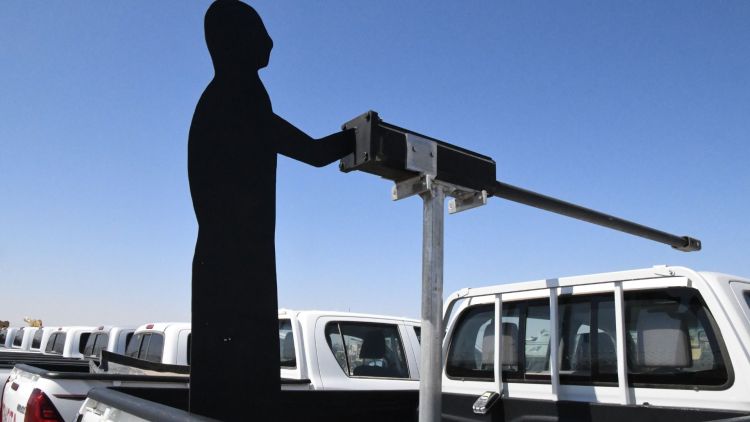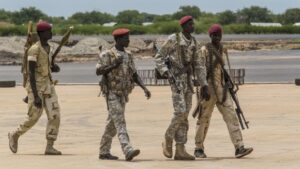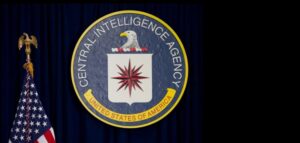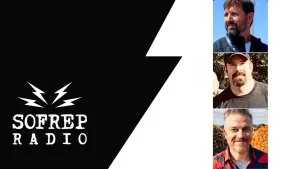Today’s Pic of the Day features a silhouette figure mounted on the back of a white Toyota truck, often associated with terrorist groups, but here repurposed as a tool for anti-terrorism training.
For those who have participated in such training exercises, you are already aware that this silhouette represents the adversaries who are often seen riding in the back of these vehicles, a common sight in areas plagued by insurgent warfare.
For years, Toyota trucks, particularly the Hilux model, have been a staple of terrorist and insurgent groups across the Middle East and Africa. Their durability, off-road capabilities, and availability make them a go-to vehicle for combat in rough terrains.
From Somalia to Syria, these trucks have been modified with heavy weapons, turning them into mobile attack platforms.
But here, the familiar symbol of insurgency is turned on its head—used not by the enemy but as part of an effort to neutralize them.
This silhouette, positioned with an extended barrel of a mock weapon, serves as a target for counter-terrorism forces to practice their marksmanship and vehicle assault tactics.
Toyota Trucks: The Unlikely Weapon of Choice for Insurgent Fighters
As earlier mentioned, one of the most striking features of many insurgent groups worldwide is their frequent use of Toyota trucks.
Insurgent groups like ISIS favor these vehicles not just because they are easily acquired but because they’re battle-tested, rugged enough to survive the harshest environments, and simple to maintain.
Today’s Pic of the Day features a silhouette figure mounted on the back of a white Toyota truck, often associated with terrorist groups, but here repurposed as a tool for anti-terrorism training.
For those who have participated in such training exercises, you are already aware that this silhouette represents the adversaries who are often seen riding in the back of these vehicles, a common sight in areas plagued by insurgent warfare.
For years, Toyota trucks, particularly the Hilux model, have been a staple of terrorist and insurgent groups across the Middle East and Africa. Their durability, off-road capabilities, and availability make them a go-to vehicle for combat in rough terrains.
From Somalia to Syria, these trucks have been modified with heavy weapons, turning them into mobile attack platforms.
But here, the familiar symbol of insurgency is turned on its head—used not by the enemy but as part of an effort to neutralize them.
This silhouette, positioned with an extended barrel of a mock weapon, serves as a target for counter-terrorism forces to practice their marksmanship and vehicle assault tactics.
Toyota Trucks: The Unlikely Weapon of Choice for Insurgent Fighters
As earlier mentioned, one of the most striking features of many insurgent groups worldwide is their frequent use of Toyota trucks.
Insurgent groups like ISIS favor these vehicles not just because they are easily acquired but because they’re battle-tested, rugged enough to survive the harshest environments, and simple to maintain.
This makes them ideal for quick hit-and-run tactics or mounting heavy weapons.
The 1987 Toyota War
The Toyota Hilux became particularly famous during the “Toyota War” in 1987, a conflict between Libya and Chad.
During this war, Chadian forces, equipped with small groups of fighters mounted on Toyota pickups, managed to defeat Libyan troops, who were using heavier armor and more sophisticated weaponry.
These agile vehicles allowed Chadian forces to outmaneuver their enemies, launching guerrilla-style attacks and quickly retreating before they could be counterattacked.
Tactical Advantage: Speed, Maneuverability, and Firepower
The Hilux became the perfect mobile platform for insurgent groups around the world after that war.
Its ability to carry heavy loads, withstand desert conditions, and still be fast enough to outpace heavier, slower military vehicles was a game-changer.
This is why groups like ISIS, Al-Shabaab, and other violent non-state actors (VNSA) have embraced the Toyota Hilux as their vehicle of choice.
With its robust design, the Hilux can easily be modified to carry mounted machine guns, making it a deadly mobile weapon.
Propaganda and Perception: Strength in Simplicity
Not only does the Toyota Hilux serve practical purposes, but it’s also a propaganda tool.
Images and videos of ISIS fighters parading in convoys of brand-new Toyota trucks helped promote their image of strength and capability, showing they had the financial means and logistical network to acquire modern vehicles.
The fact that these insurgent groups could acquire such vehicles through black markets, illicit networks, or simply by capturing them from government forces only added to their mystique.
The Legacy of the Toyota Hilux in Conflict Zones
In short, the Toyota Hilux has proven time and time again that it’s the vehicle of choice for insurgents—not just because of its availability, but because of its unique ability to thrive in conflict zones. The Toyota War of 1987 solidified its legacy as a battlefield tool, and it continues to play a central role in conflicts today.
Chadian soldiers on a Toyota Land Cruiser pickup truck circa 2008. (Wikimedia Commons)
The Art of Making Targets: Inside YPG’s Target-Making Wizards
Going back to the featured photo, this was taken at the US Army Yuma Proving Ground (YPG), which has been at the forefront of ensuring our troops have the most reliable tools in the field for over eight decades.
Whether it’s munitions, artillery, or aircraft, they all need one crucial component: targets. Without them, there’s no way to assess the accuracy of firing systems or the effectiveness of radar-tracking capabilities in drones and aircraft.
This is a prime example of YPG’s Threat Systems Target Simulations (TSTS), a team who meticulously craft everything from simple silhouettes like this one to complex, high-fidelity mobile targets.
The TSTS team is known for being super innovative, and their work is a big part of what makes American military training so effective.
Whether it’s something as simple as this silhouette or a high-tech, remote-controlled replica of enemy equipment, these targets are critical for testing everything from weapons systems to aircraft radars and drones. They’ve even converted motorcycles, trucks, and other vehicles into remote-controlled moving targets.
A self-guided FGM-148 Javelin missile is in action during operational testing at the US Army Yuma Proving Ground, 2023.(DVIDS)
Some of these targets even have hydraulic parts, rotating sections, and heat signatures, making the training more realistic and helping improve sensor technology.
In an October 2021 article, TSTS supervisor Randy Ehrlich sums up their work well, saying:
“We don’t say ‘no’ to much—we’ll figure it out, we’ll design it.”
It was said that the team is made up of skilled fabricators, mechanics, and electronic technicians who don’t just build these targets—they’re also the ones out in the field, setting them up and keeping them running.
Some of the targets are replicas of foreign threat systems that our adversaries might use, and the team has a knack for recreating them from nothing more than a few photos.
They’re experts at taking an image and turning it into a life-sized, moving target, even if they’ve never seen the real thing up close.
While a lot of the targets they make end up getting blown to pieces during live-fire exercises, there are no hard feelings from the team. As Senior Electronic Technician Jose Velazquez says:
“As soon as the target is destroyed, that’s direct feedback that my mission was accomplished.”
And it is, as you know how in training exercises like these—where quick, accurate decision-making can mean the difference between life and death—realism is key.
Marines perform shooting drills at the YPG, 2016. (DVIDS)
Final Thoughts: The Role of Realism in Training
At the end of the day, the work being done at YPG and by teams like TSTS goes far beyond just building targets.
It’s about creating realistic scenarios where our troops can train as if they were already on the battlefield.
Whether it’s a simple silhouette like the one mounted on the back of this Toyota truck or a highly detailed, remote-controlled replica of enemy systems, each target plays a critical role in preparing our Warfighters for the real thing.
—
Disclaimer: SOFREP utilizes AI for image generation and article research. Occasionally, it’s like handing a chimpanzee the keys to your liquor cabinet. It’s not always perfect and if a mistake is made, we own up to it full stop. In a world where information comes at us in tidal waves, it is an important tool that helps us sift through the brass for live rounds.



